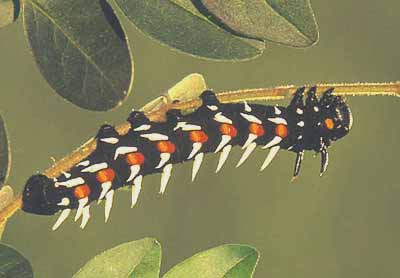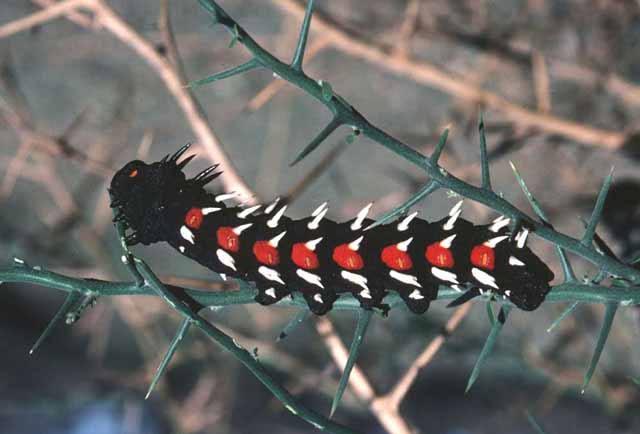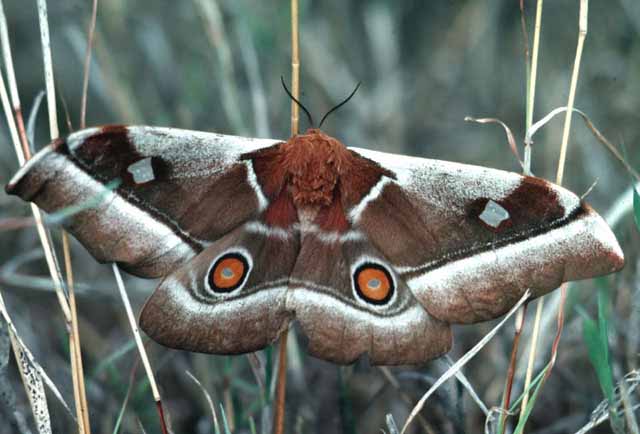The Cabbage tree emperor moth,
Bunaea alcinoe, derives its common name
from the fact that its caterpillars have a preference for
cabbage trees (Cussonia), where they can be found during
December.

Bunaea alcinoe caffra male and Epiphora magdalena male,
Kilimanjaro's lower montane forest at 1800m, courtesy of David Bygott. ID by Philippe Darge.
ECLOSION, SCENTING AND MATING:This species emerges at
dusk and females attract the night flying males with an airbourne
pheromone.
The pair remains coupled for a relatively short time.
Females have thinner and blacker antennae and their abdomens are
much broader and forewings are more rounded than in males.
EGGS, LARVAE AND PUPAE:Eggs are large,
round, and cream coloured, and have a deep indentation at the
micropyle.Larvae prefer fresh food and a warm, humid atmosphere.
In the final instar, airy conditions are preferred. When larvae are
disturbed they will lash their heads and front segments violently
back and forth.
|  |
Rough,
black pupae are formed deep (10-15 cm) underground. Under artificial
conditions pupae will emerge after being kept moist following
immersion in tepid water.

Bunaea alcinoe caffra Tanzania, courtesy of David Bygott.
The question of subspecies and
differences in larval colouration.
Rolf Oberprieler recently wrote, "The larva of Bunaea alcinoe
does indeed come in two rather distinct colour forms. In West and
Central Africa it is mostly brick-red with yellow spines (except the
first two pairs, the thoracic ones, which are black), and in southern
and eastern Africa it is entirely black with white spines
(again except the black thoracic ones). The S-E African form is very
constant, i.e. always completely jet-black, but the W-C African form
can also be black instead of red, although the spines always seem to
be yellow, never white. There are colour illustrations of both types
in the literature, but I would have to comb through my literature to
find the best or first in both cases. The red W-C form is figured in
colour i.a. by Rougeot (1955, fig. 13 – not very good), and Paul
Latham in his recent booklet on the edible caterpillars of
Bas-Congo gives a nice photo of the black W-C form (on p. 12) and
also one with both forms together (p. 3). Boorman (1970) in his
booklet on the emperor moths of Nigeria also said that there are
these 2 colour forms in Nigeria (the black one app. having black
spines – I’ve not seen this confirmed, though). His fig. (plate 2) is
only black-and-white but seems to represent the black form.
"I may have the book Howard mentions as containing a description of
larva in Nigeria, but it’s not one of the well-known ones and I can’t
find it in a hurry. At first I thought it may have been Packard
(1914), who covered different fauna’s together and used old names
like Caligula, but the page numbers don’t match. Would appreciate if
you could get me the author so that I can check.
"Regarding the taxonomy and nomenclature of the species, one CAN’T use
the name caffraria for the W-C African form (“subspecies”) of
B. alcinoe. Firstly because caffraria, established by Stoll
(1790) as Phalaena (Attacus) caffraria, is a junior primary
homonym of Phalaena caffraria Linnaeus, 1767 in Geometridae
and thus NOT an available name in Saturniidae. Its replacement name
is caffra Huebner, 1819. Secondly because Stoll’s name was actually
erected for the southern African form, not the W-C African one, so if
you recognise such subspecies in B. alcinoe, caffra can only
apply to a southern (or south-eastern) one.
"But, as I wrote the other day, such a division of B. alcinoe into
subspecies is problematic also for other reasons. Firstly, it is
difficult to distinguish (separate) a possible W-C and S-E form
(“race”, “subspecies”) because there don’t appear to be clear-cut
differences and a clear geographical division between such forms. In
theory this might occur on the eastern border of the Central African
rainforests, but it seems no-one has investigated this in detail yet.
Secondly, we can’t be certain to which population the name alcinoe
really applies, as already Stoll didn’t know where the type specimen
came from, and his illustration is not clear enough either. If
alcinoe was described from somewhere in West Africa, this would be
the valid name for any W-C form or “subspecies”, and caffra the valid
name for a S-E form. However, if the type specimen of alcinoe
actually also came from southern (or eastern) Africa, the S-E form
would carry the name alcinoe (with caffra its synonym), and the
W-C form would take the next-oldest name established for it.
Oberthuer (1910) investigated this issue in the past but didn’t
resolve it, and I’m not sure whether anyone since has found Stoll’s
type and re-interpreted it.
"If alcinoe is not referable to the W-C form, working out this
next-oldest name is again a thorny issue. The oldest names clearly
assignable to the W-C form would be one of Dufrane’s (alberici,
atlantica, katangensis), all described in 1953 from Zaire. However,
there are also Rothschild’s tricolor from Ethiopia (1895),
Oberthuer’s alcinoina from Mpala in Tanzania (1910) and Jordan’s
nubica from Sudan (1910), and one would first have to sort out
whether these populations belong to the W-C or the S-E form. There’s
also punctigera Wallengren, 1860, for which we also have no type
locality and thus no clear evidence of where it is from. The last 5
available species-group names are mostly from southern Africa and
all referable to the S-E form.
All in all quite a mess, as you can see. The best option for the time
being (April 2005) is therefore not to attempt any division into
subspecies and just refer to the species as Bunaea alcinoe wherever
it occurs. Just forget about caffraria and caffra and all this
subspecific stuff. Except for Madagascar that is, the species there
(B. aslauga) is different.
"Hope this clarifies things. It’s a rather convoluted affair,
unfortunately."
Rolf had written in response to email I shared from Howard Romack:
Howard's Email:
"Hi Bill,
I collected caterpillars- brick orange in color with black
spines- several years ago while collecting in Liberia. I was there
for six weeks, and many of the moths and other arthropods were
difficult to classify, but I managed to obtain a few pupae from
these large, polyphemus-sized larvae. Eventually the adults emerged,
and with the help of specialists, discovered that the moths
were B. a. caffraria. The larva you pictured
(#6 on another site) is nothing like those, and there were hundreds
of them tumbling out of the trees, (a trait that these big
caterpillars do preceeding burrowing into the ground) that I found in
Liberia. I might also tell you that I have one bilateral
gynandromorph of this moth that, after soaking the pupa
in warm water, finally emerged among the others."
Howard also reports a "book" in which he found the
"description of the larva, from Nigeria, of
B. a. caffraria Stoll (= caffra Hubner = Nytalops Wallengren =Derbania Oberthur) The
Nigerian larva changes color to "brick-red" in the third instar....
This moth is a spectacular creature- it emerged here at home in an
aquarium after I submerged the pupae in a sink of warm water. They are truly armor plated, and
obiously won't emerge until the next rainy season following pupation.
Oftentimes, heavy rains wash them out in windrows! The adults were
very common at our collecting lights over there."
I will post any additional information that becomes available. I have
also added these comments to the Bunaea alcinoe caffra file.
Thanks to both Howard and Rolf for shared information.
Larval Food Plants
Listed below are primary food plant(s) and alternate food plants listed in Stephen E.
Stone's Foodplants of World Saturniidae. It is hoped that this
alphabetical listing followed by the common name of the foodplant will
prove useful. The list is not exhaustive. Experimenting with closely
related foodplants is worthwhile.
Bauhinia reticulata
Cassonia spicata
Celtis
Crataegus
Croton
Ekebergia meyeri
Ekebergia ruepellii
Gymnosporia senegalensis.....
Harpephyllum caffrum
Khaya senegalensis
Ligustrum
Maesa lanceolata
Prunus
Pyrus malus
Quercus robar
Rhus glabra
Terminalia catappa
|
Kanchan
Cassonia
Hackberry
Hawthorn
Croton
Ekebergia
Ekebergia
Gymnosporia
Kaffir plum
Red mahogany
Privet
Maesa
Cherry
Apple
English oak
Smooth sumac
Indian almond
|
Use your browser "Back" button to return to the previous page.
h3>Return to Bunaea Genus
Go to Index for African Saturniidae
Go to Main Index for all Worldwide Saturniidae
|




